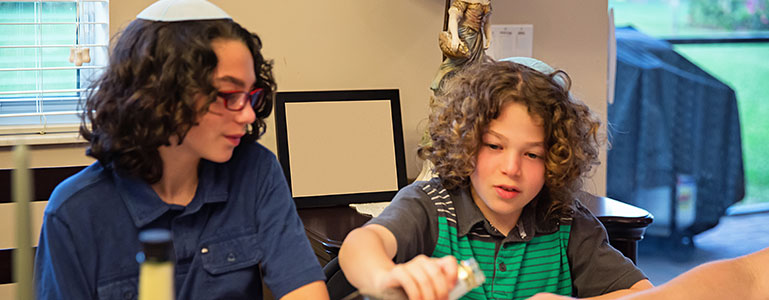Spring has sprung and as the Center for Children and Youth is part of Jewish Family and Children’s Services, many in our community are getting ready for Passover. Each year, it’s important to take a little time to think about this holiday through the eyes of children, and even if you don’t celebrate, the role of children in the Passover celebration can provide a thoughtful learnings.
An important moment in the Passover Seder (traditional holiday meal) comes when you tell the story of The Four Children. The story is that four children were at the first Passover Seder; one was wise, one was wicked, one was simple, and one did not know how to ask a question. While calling a child simple or wicked may seem unfair, looking at this story through the lens of child development invites a different perspective. What if these four children were actually one child at the various stages of development on their journey to adulthood?
So, how can you make your Seder appropriate for children at each stage of their growth? Here are some ideas to consider:
The Child Who Did Not Know How to Ask a Question—Babies and Toddlers
Developmentally let’s flip the order of the Four Children and start with the Child Who is Too Young to Ask a question, a stage otherwise known as infancy/toddlerhood. Perhaps this is her first Passover Seder, she is too new to this experience, she is not yet aware enough to question what is going on around her. Through her senses of taste, sight, hearing and smell she is just learning to make sense of her environment. Let her taste the salt water and smell the delicious smells of matzah ball soup. Let her feel the roughness of the matzah and the soft pillows for reclining to differentiate between the hardness of slavery and luxury of freedom. Use musical instruments and let her shake a maraca to the beat and fill the Seder with songs and laughter and celebration.
The Simple Child—Elementary school-aged kids
Next is the Simple Child in his latency phase of development, the elementary school child, who might be learning about the story of Passover in school. He is curious but perhaps a bit overwhelmed by the commotion and unable to participate by asking his own questions quite yet. To engage him, ask what he knows about the holiday. Ask him about the symbols of the Seder plate and what it means to him. Ask him to lead the familiar songs that he may have learned in class. Or give him a job like helping to set the table or pass out and collect the Haggadot (prayer books) to help make him feel like he is participating—even if he is too shy to speak up and contribute verbally.
The Wicked Child—Pre-teens and Teens
Third is the Wicked Child, better known as the pre-teen or adolescent. This child is questioning everything! It is her job to question why she is forced to participate in these traditions. It is her job to resist against conforming and doing what everyone else is doing. Let her question and support her self-searching. Unlike the Father in the Hagaddah do not exclude or punish her for her stance, instead applaud her insight and self-awareness. Then, encourage her participation by asking her questions that are relevant to her. Does she feel like a slave to anything in her life? Are there times when she feels free? What would she define as the 10 plagues of the modern day? Encourage her in these rich and ancient traditions because they are special and will play a large part in her identity as a Jewish person and will strongly influence her unique Jewish Journey.
The Wise Child—Young Adults
Finally, the Wise Child— the Young Adult who has gone through the storming and norming of adolescence and has come out on the other side. Perhaps he is home from college full of independence and moxie. Ask him about his freedom. Ask him about his world views. Invite him to lead part of the Seder in order to prepare him for the day when he will sit at the head of the table with his family.
As the adults, parents, and grandparents, it is our turn now to start making traditions in our own homes for our family. Let us not forget to start where our children are and encourage them to ask questions, no matter where they are on their journey to adulthood.

